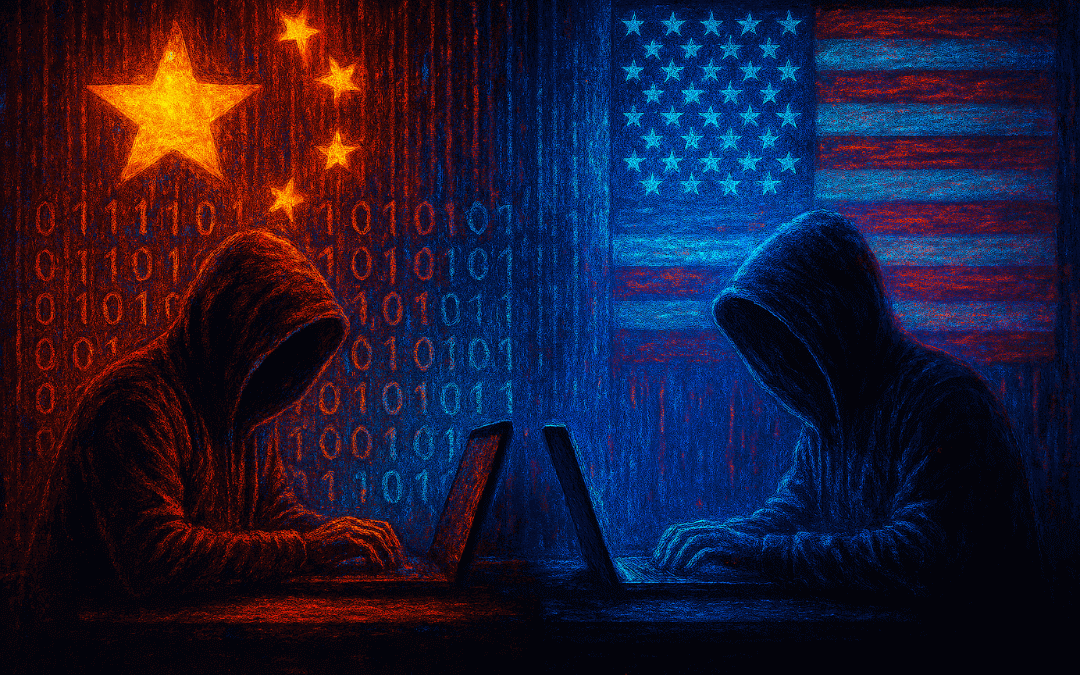If last week’s deep dive into ransomware and AI threats had you bolting your digital doors, this one’s a geopolitical thriller: straight out of the shadows of the US-China cyber war. China’s Ministry of State Security just dropped a bombshell, accusing the US National Security Agency (NSA) of launching sophisticated cyberattacks on its National Time Service Center—a linchpin for everything from financial transactions to national defense.
Is this a rare peek behind the curtain of state-sponsored hacking, a deflection tactic, or the spark that ignites an even hotter cyber cold war? We’ll break down the claims, the context, and what it means for businesses caught in the crossfire. Buckle up; the tables might be turning, but the heat is definitely rising.
The Accusation: A High-Stakes Strike at Time Itself
Picture this: It’s the beating heart of a nation’s infrastructure, synchronizing clocks across communications, power grids, finance, and military ops. That’s China’s National Time Service Center, and according to Beijing, it was ground zero for a multi-year NSA assault in the ongoing US-China cyber war. Unveiled via a WeChat post on October 19, 2025 (just yesterday as of this writing), the Ministry of State Security laid out a timeline of alleged intrusions that read like a spy novel plot twist.
Here’s the play-by-play, pieced from the ministry’s investigation:
| Phase | Timeline | Tactics Employed | Potential Impact |
| Initial Breach | 2022 | Exploited vulnerabilities in a foreign mobile phone brand’s messaging service to steal sensitive data from staff devices | Compromised personal and work communications, creating a foothold for deeper access |
| Escalation | 2023–2024 | Deployed 42 specialized “cyberattack weapons” against internal networks; attempted infiltration of the core timing system | Could disrupt national time standards, cascading to failures in finance, power, transport, and defense systems |
The ministry claims their probe uncovered “solid evidence” of NSA involvement, framing it as a hypocritical move: “The US is accusing others of what it does itself, repeatedly hyping up claims about Chinese cyber threats.” No specifics on the evidence were shared publicly—classic in these ops—but they did offer the center remediation guidance to patch the holes. The US Embassy? Radio silence so far, with no immediate rebuttal.
This isn’t just tech sabotage; it’s existential. Mess with time signals, and you unravel economies and militaries. Think GPS blackouts or stock market freezes, but on steroids.
The Bigger Picture: Tit-for-Tat in the US-China Cyber War Shadows
Are the tables turning? Let’s pump the brakes. This accusation lands amid a barrage of mutual finger-pointing that’s defined US-China cyber war relations for years. The West has long accused Beijing of state-backed hacks: from targeting US officials and journalists to corporate espionage via groups like APT41. Just this year, Microsoft called out Chinese actors for infiltrating US critical infrastructure, including water and energy sectors. China, meanwhile, has flipped the script—last month, they blamed the NSA for university breaches, and researchers spotlighted an NSA-linked Linux backdoor.
Zoom out, and it’s a feedback loop of escalation:
- Espionage Overload: Both sides prioritize intel gathering. The NSA’s PRISM program (exposed by Snowden) showed US reach into global comms, while China’s “Salt Typhoon” ops allegedly hit US telecoms.
- Weaponization Wave: Hybrid threats blend cyber with geopolitics—Taiwan tensions, trade wars, tech bans. This time center hit? It echoes how disrupting timing could cripple military coordination, hinting at preemptive wartime prep in the US-China cyber war.
- Attribution Arms Race: Proving “who did it” is cyber’s holy grail. Tools like MITRE ATT&CK frameworks help, but deniability reigns. Microsoft’s 2025 report (yep, tying back to last week) noted a 25% uptick in state-sponsored attacks on SMBs as unwitting proxies.
If tables are turning, it’s more like a merry-go-round spinning faster. China’s reveal could be legit retaliation intel or a savvy PR jab to undercut US narratives ahead of key summits. Either way, it underscores a grim truth: Cyber’s the new battlefield where shots fired cost nothing upfront but billions in fallout, especially in the escalating US-China cyber war.
Caught in the Crossfire: Lessons for Businesses Worldwide
For SMBs and enterprises alike, this isn’t distant drama—it’s a wake-up call in the midst of the US-China cyber war. State actors don’t discriminate; they pivot through your supply chain or endpoints. Remember SolarWinds? A nation-state hack that rippled to thousands of firms. Here’s how to shield up without a black budget:
- Harden Your Perimeter, Assume Breach
Zero-trust architecture is non-negotiable: Verify every access, segment networks (e.g., isolate timing/sync-dependent systems like NTP servers). Tools like CrowdStrike or Palo Alto’s free assessments can spot NSA-style persistence. - Patch Proactively, Scan Ruthlessly
Those 2022 mobile vulns? A reminder to audit third-party apps and devices. Automate patching with WSUS or Intune, and run regular vuln scans—focus on messaging apps, as they’re low-hanging fruit for initial footholds. - Monitor for Anomalies, Especially Time Shenanigans
Watch for clock drifts or unauthorized NTP traffic; tools like Splunk or open-source Zeek flag stealthy probes. Behavioral analytics (à la last week’s AI tips) catch the “42 weapons” equivalents early. - Geopolitical Awareness in Your Stack
Diversify vendors—don’t bet everything on one “foreign” supply chain. Join info-sharing alliances like CISA’s or FIRST.org for real-time threat intel on state ops. And train your team: Phishing from nation-states mimics extortion, but the payload’s regime change. - Incident Prep with a Global Lens
Update your IR plan for attribution delays—don’t wait for headlines. Cyber insurance? Ensure it covers state-sponsored riders, as premiums are spiking amid these headlines.
Bottom line: In this heating US-China cyber war, agility wins. SMBs, you’re nimble—use it to outpace the giants.
Final Thoughts: Escalation or Equilibrium?
Has the cyber war heated up? Absolutely—this accusation adds fuel to an already smoldering pile of mutual distrust. Tables turning? Maybe for optics, but it’s symmetric warfare: Both superpowers wield shadows, and we’re all in the glare. As tensions simmer over Taiwan and tech, expect more unmaskings. The real pivot? Shifting from blame to norms—global cyber treaties anyone?
What do you think—is this the new normal, or a bluff? Stay tuned for next week’s edition. Until then, sync your watches and secure your networks.
Click here to read more blog articles!

